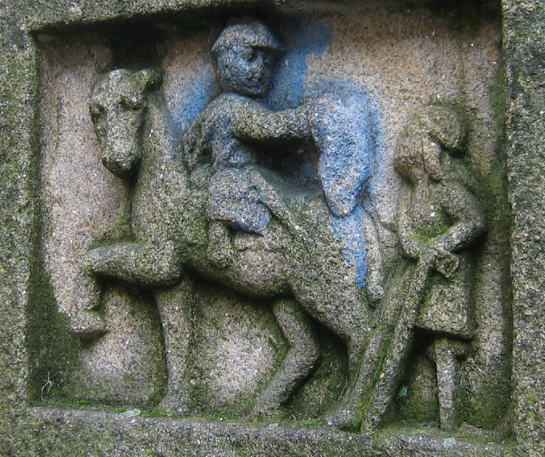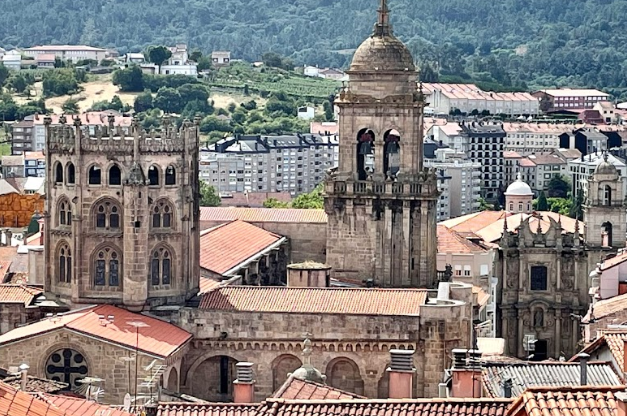La cathédrale Saint-Martin d’Orense ou Ourense, en Galice, est construite entre le XIIe et le XIIIe siècle à l’emplacement d’une première basilique Suève construite en 572 et devait sans doute être déjà dédicacée à saint Martin, patron de la ville (certaines études placent tout de même cet édifice à l’emplacement de l’église Santa Maria Madre). L’actuelle cathédrale est construite en croix latine, dans un mélange d’architecture romane et gothique, puisqu’elle a fortement été remaniée entre 1499 et 1505. Le maître-autel est consacré en 1188. Des reliques de saint Martin y sont alors déposées à l’intérieur.
La cathédrale d’Orense conserve d’autres reliques de saint Martin. Tout d’abord un bras-reliquaire. Le bras est représenté recouvert d’une manche avec des plissures, se terminant par des dentelles. La main est ouverte et la relique se trouve en son centre, dans une lunule ovale. Le pied du reliquaire est orné de motifs géométriques encadrant une tête d’ange ailé. Sur chaque faces de la base carrée se trouve une inscription : « DIGITUS. » ; « S. MARTINI » ; « EPISCOP. » ; « TURON. P.C.A.V. ». Il s’agit donc d’une relique d’un doigt de saint Martin. Elle est disposée à la verticale, sur fond rouge, maintenue par deux bagues, et porte une étiquette sur laquelle est écrit : « Sti martini ».
Albert Lecoy de la Marche signale dans son ouvrage Saint Martin (p.492) que l’on conserve à Orense des poussières du tombeau de saint Martin sous le nom de « poussière de la chair de saint Martin » Le musée d’Orense, qui se trouve dans la cathédrale, abrite encore aujourd’hui un reliquaire de saint Martin, peut-être est-ce celui mentionné par Lecoy de la Marche.
Le tissu de soie est-il la relique qui a été déposée dans l’autel de la cathédrale Saint-Martin d’Orense, en Galice, en 1188, pour sa consécration ?
La cathédrale Saint-Martin est déclarée monument national en 1931.
Une charité de saint Martin figure en bas-relief sur le socle d’une croix monumentale

Se promener virtuellement dans la cathédrale : cliquez ici
Saint Martin’s Cathedral in Orense or Ourense, in Galicia, was built between the 12th and 13th centuries on the site of a first Suevian basilica built in 572 and was probably already dedicated to Saint Martin, patron of the city (some studies still place this building on the site of the Santa Maria Madre church). The current cathedral is built in a Latin cross, in a mixture of Romanesque and Gothic architecture, since it was greatly altered between 1499 and 1505. The high altar was consecrated in 1188. Relics of Saint Martin were then placed there. inside.
The Cathedral of Ourense preserves other relics of Saint Martin. First of all an arm-reliquary. The arm is shown covered with a sleeve with pleats, ending in lace. The hand is open and the relic is in its center, in an oval lunula. The foot of the reliquary is decorated with geometric patterns framing the head of a winged angel. On each side of the square base is an inscription: “DIGITUS. » ; “S. MARTINI”; “EPISCOP. » ; “TURON. P.C.A.V. « . It is therefore a relic of a finger of Saint Martin. It is arranged vertically, on a red background, held by two rings, and bears a label on which is written: « Sti martini ».
Albert Lecoy de la Marche points out in his work Saint Martin (p.492) that dust from the tomb of Saint Martin is kept in Orense under the name of « dust from the flesh of Saint Martin » The museum of Orense, which is in the cathedral, still houses today a reliquary of Saint Martin, perhaps the one mentioned by Lecoy de la Marche.
Is the silk fabric the relic that was placed in the altar of Saint Martin’s Cathedral in Orense, Galicia, in 1188, for its consecration?
Saint Martin’s Cathedral was declared a national monument in 1931.
A charity of Saint Martin figures in bas-relief on the base of a monumental cross
Bibliographie :
Natalia CONDE CID, La catedral de Ourense como imagen del Paraíso en la Edad Media : Arquitectura, cultura visual y espacio para la penitencia, Thèse de doctorat, Departemento de Historia da Arte, Facultade de Xeografia e Historia, Santiago de Compostela, septiembre 2015.
José CAMON AZNAR, La escultura y la rejería españolas del siglo XVI, Summa Artis, Historia general del arte, Vol. XVIII, Espasa Calpe, Madrid, 1961.

 "/>
"/>